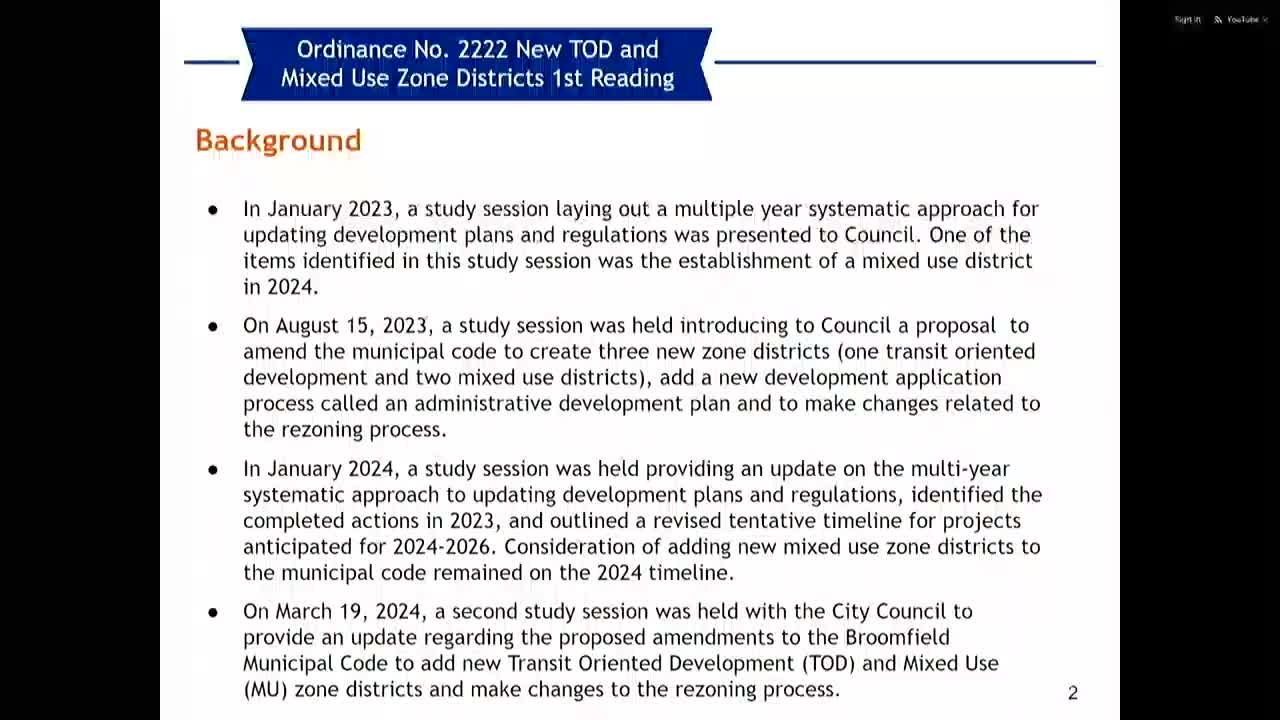Broomfield proposes new zoning to tackle housing crisis
July 02, 2024 | Broomfield City, Broomfield County, Colorado

This article was created by AI summarizing key points discussed. AI makes mistakes, so for full details and context, please refer to the video of the full meeting. Please report any errors so we can fix them. Report an error »

In a recent City Council meeting, officials discussed a proposed ordinance aimed at creating three new zoning districts in Broomfield, Colorado, as part of an ongoing effort to enhance urban development and address the local housing crisis. This initiative has been in the works for approximately 18 months, with significant input from the community and stakeholders.
The proposed zoning districts include two mixed-use areas and one transit-oriented development (TOD) district. The goal is to facilitate high-quality development that integrates residential and non-residential uses while promoting transit accessibility. The new zoning framework is designed to bridge traditional zoning methods with Planned Unit Development (PUD) zoning, allowing for more detailed development expectations.
Key features of the proposal include a requirement for property owners to request rezoning before any development can proceed. This process will involve submitting preliminary engineering reports and conducting neighborhood meetings to gather community feedback. The ordinance also outlines specific density and height regulations for each district, with the TOD district allowing for a maximum of 85 dwelling units per acre and heights up to 85 feet.
During the public comment segment, Lucas Hagen, a representative from the Neighborhood Development Collaborative, urged the council to adopt the new zoning districts, highlighting the urgent need for affordable housing in Broomfield. He noted that only 5% of homes sold in 2021 were affordable for low-income households, with average rents soaring to over $2,000 per month in 2023. Hagen emphasized that the proposed districts could help alleviate housing shortages and reduce reliance on cars by promoting density near transit.
The council is expected to hold a public hearing on the proposal on July 30, following a first reading of the ordinance. The discussions reflect a broader commitment to addressing housing affordability and sustainable development in Broomfield, with ongoing collaboration between city officials and community organizations.
The proposed zoning districts include two mixed-use areas and one transit-oriented development (TOD) district. The goal is to facilitate high-quality development that integrates residential and non-residential uses while promoting transit accessibility. The new zoning framework is designed to bridge traditional zoning methods with Planned Unit Development (PUD) zoning, allowing for more detailed development expectations.
Key features of the proposal include a requirement for property owners to request rezoning before any development can proceed. This process will involve submitting preliminary engineering reports and conducting neighborhood meetings to gather community feedback. The ordinance also outlines specific density and height regulations for each district, with the TOD district allowing for a maximum of 85 dwelling units per acre and heights up to 85 feet.
During the public comment segment, Lucas Hagen, a representative from the Neighborhood Development Collaborative, urged the council to adopt the new zoning districts, highlighting the urgent need for affordable housing in Broomfield. He noted that only 5% of homes sold in 2021 were affordable for low-income households, with average rents soaring to over $2,000 per month in 2023. Hagen emphasized that the proposed districts could help alleviate housing shortages and reduce reliance on cars by promoting density near transit.
The council is expected to hold a public hearing on the proposal on July 30, following a first reading of the ordinance. The discussions reflect a broader commitment to addressing housing affordability and sustainable development in Broomfield, with ongoing collaboration between city officials and community organizations.
View full meeting
This article is based on a recent meeting—watch the full video and explore the complete transcript for deeper insights into the discussion.
View full meeting
